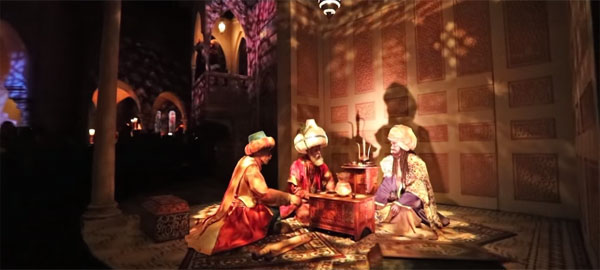
Following Rome’s unfortunate demise, our journey switches gears with positive news. All is not lost! Islamic and Jewish scholars have helped to ensure the knowledge is saved and keep us moving forward. The pace is picking up as information sharing becomes more common across the world. Each version of Spaceship Earth has a slightly different way to describe this process. The best description comes from Jeremy Irons:
“But all was not lost. For far across the land, from Cairo to Cordoba, Jewish teachers and Islamic scholars continued the quest for knowledge. In libraries of wisdom, they debated ideas and shared new discoveries with all who would listen.”
I love this statement because it focuses on the search for wisdom, not just saved information. Scholars are sharing discoveries with each other and doing more than keeping historical records. The knowledge provides the foundation for exciting debates and novel ideas. We observe this type of conversation as four men (three today) sit on pillows around a table.
Neil Engel, art director of the 2007 version, described to me how they added a four-sphere perforated chain chandelier that cast a pattern on the scholars. This change heightens the impact of this laid-back scene, which effectively conveys the idea of a global neighborhood.
After passing the thinkers, we observe an astronomer standing high on a balcony. Armed with knowledge, he’s looking off into the distance at stars. Effective art direction brings scale to a scene that’s actually pretty small. According to Jim Korkis, the astronomer holds a quadrant reproduced from photos of a 10th century Islamic quadrant supplied by the Metropolitan Museum of Art. Engel also noted that they put more light on the astronomer, which improves our view. It’s one of many examples where details and place making spice up even fairly straightforward moments.
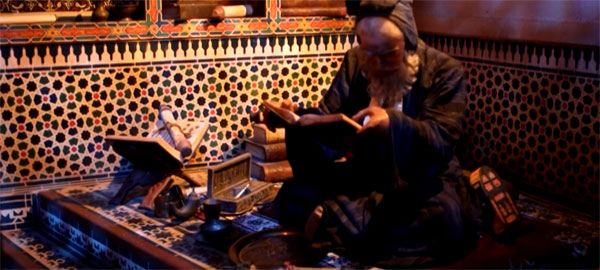
Noble Libraries
On the left side of our vehicle, we pass an early library with books on the shelves. It’s a quick scene but does enough to nail the point. To quote Walter Cronkite, “noble libraries” saved knowledge and allowed our journey to keep progressing. During the first three Spaceship Earth incarnations, we see two figures (one standing and one seated on pillows) read books here. Engel clarified that the standing figure was transformed into a computer checker for the new scene. The extra space in 2007 does help the details stand out in what’s quite an intricate area.
The older scholar that stays receives more attention now, and his collection of tools on the pillows is worth a close look. The previous versions give the sense that the two men are collaborating to build knowledge, and now our remaining figure has become a solo thinker. Vic Perrin fails to mention the libraries but also has a great line about the process:
“Far from the dieing embers, Islamic wise men preserve ancient wisdom and weave a rich network of new knowledge linking East and West.”
Once again, I love the elegance of the language from the 1982 attraction. It might seem too high-minded for some guests, but the written artistry matches the wonderful designs on the ride. This line is a far cry from the approach taken with Judi Dench’s narration. Calling the libraries the “first back-up system” isn’t as unfortunate as connecting Ancient Rome to the World Wide Web, but it’s not great either. There’s also an interesting change from using “Islamic” to “Arab” when describing the scholars in 2007. I won’t speculate on the reason for the edit, but it’s worth noting.
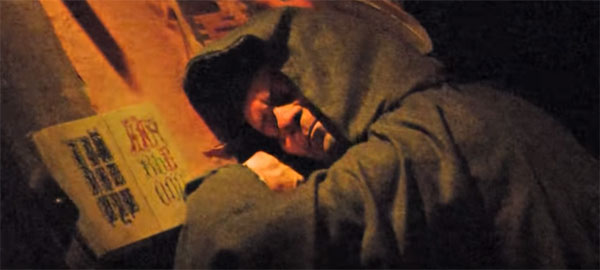
The Sleeping Monk
One of my dad’s favorite spots in a Disney park has always been the reveal of the sleeping monk inside Spaceship Earth. While it might fit better inside the gag-filled World of Motion, the monk offers a refreshing bit of levity inside a serious attraction. I appreciate that Disney has kept this joke intact in all four versions. The narrator’s set-up is also similar with the phrase “monks toil endlessly” used in each statement. Seeing the monk’s breathing while he sleeps is a minute effect but helps to sell the joke. This guy isn’t just taking a five-minute nap; he’s down for the count.
This medieval scene in Europe begins the transition to the printing press and more rapid progress. Instead of recording books by hand, there’s a new invention to save the day! But that subject will have to wait for the next blog.
Looking closer at this scene, it includes detailed manuscripts that remind us of the commitment to authenticity within Spaceship Earth. Korkis indicated that Mary Robertson — curator of Rare Manuscripts at the Huntington Library in San Marino, California — was consulted on the creation of these documents. It represents another example of how Disney went above and beyond to help depict the scene.
This scene is largely unchanged since the beginning, but there are some notable updates. The 1994 version cranks up the score with audio you’d expect to hear along with monks. It’s a little overdone but does ratchet up the scene’s energy. That audio did not remain in 2007, but the physical sets look sharper. Engel mentioned that they added new floor and table-mounted candlesticks to create more believable lighting. I’ve really started to notice how the smaller changes to the current attraction build just the right atmosphere.
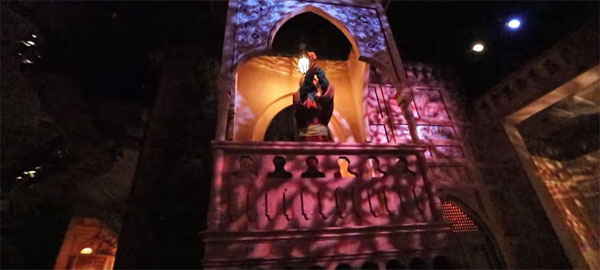
The Future is Saved
Despite significant changes in each version, the overall theme of these scenes remains consistent. The narrators stress the importance of preserving wisdom and the dangers caused by the fall of Rome. In Dench’s words, “books are saved, and with them our dreams of the future.” These are transitional scenes yet still move the story forward. Keeping information afloat was a real challenge before the inventions that changed everything. We reached the depths of the Dark Ages, but all was not lost. The pace of this journey is about to increase, and I can’t wait to see it.
Next time, a new dawn emerges with the origins of the printed word. We’ll journey to the Renaissance and experience all types of majestic art inside our Spaceship Earth. Stay tuned!
Sources: INTERCOT, Martin’s Videos, Mouseplanet, Secret Stories of Walt Disney World by Jim Korkis
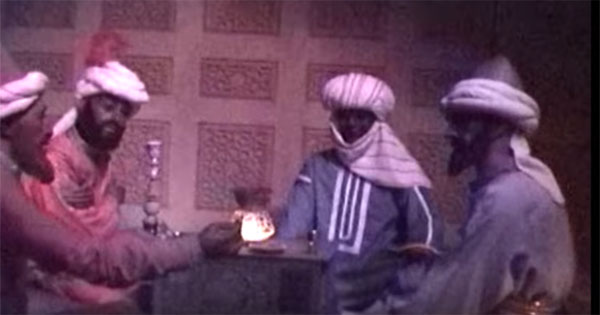
Related Articles: Books Are Saved!
Spaceship Earth, Scene by Scene: The Theater (and Math) is Born
Five Steps to Enhance Spaceship Earth
Spaceship Earth, Scene by Scene: The Ancient Egyptians
Spaceship Earth, Scene by Scene: Thank the Phoenicians!
This post contains affiliate links. Making any purchase through those links supports this site. See full disclosure.



This is by far the most disappointing bit of narration in the current attraction. Those scholars weren’t sitting on Western knowledge, waiting for the Renaissance, they were advancing knowledge. Ever wonder why some stars have decidedly Arabic-sounding names or why the words “algebra” and “algorithm” have Arabic roots? It’s because there were scientists advancing knowledge while people in Europe were burning witches and trying to not die of the plague.
Right. Calling it a back-up system doesn’t do justice to the forward progress, which was clearer in the earlier versions. The effort to connect the current script to our daily lives didn’t do it many favors overall.